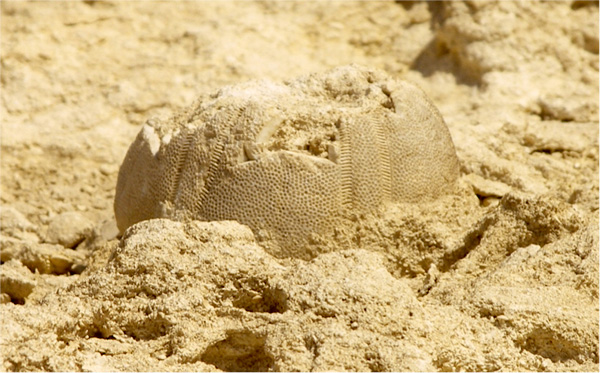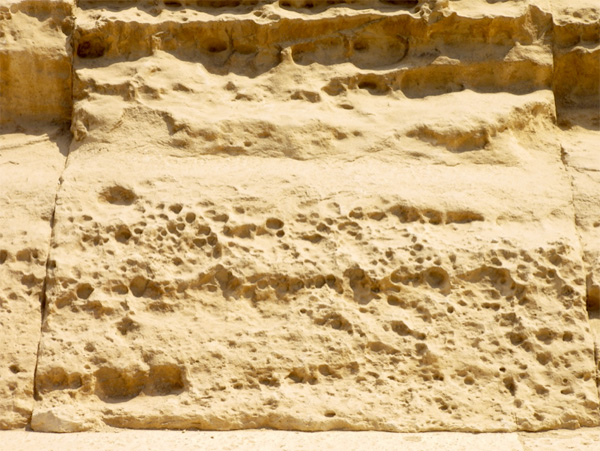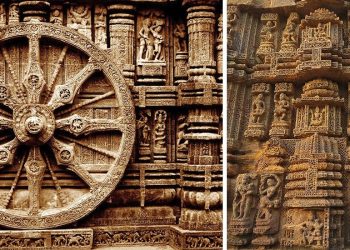Could the pyramids and Sphinx have been submerged under water in ancient times? Well… the theory that the pyramids and Sphinx were submerged under ancient floodwaters is supported by erosion patterns—and one curious fossil find on the Giza Plateau.
A fossil at Giza fuels ancient flood theory

Archaeologist Sherif El Morsi, who has studied the Giza Plateau for over two decades, made a surprising observation while documenting erosion patterns near the Sphinx. Alongside researcher Antoine Gigal, he spotted what appeared to be a marine fossil embedded on the surface of a temple block.
“To my surprise, the bump on the top surface of the block that almost tripped me was, in fact, an exoskeleton of a fossil of what appears to be an echinoid (sea urchin), which are marine creatures that live in relatively shallow waters,” El Morsi explained.
According to him, the condition and placement of the fossil suggest it wasn’t formed millions of years ago within the limestone itself—but was instead preserved after being deposited in more recent times, likely when the Giza Plateau was underwater.
Evidence the pyramids and Sphinx were submerged?
El Morsi and Gigal argue that this fossil supports a broader idea first proposed by geologist Dr. Robert Schoch in the 1990s: that erosion on the Sphinx and other Giza monuments was caused not by wind or sand, but by significant exposure to water. Schoch suggested the Sphinx could date back as far as 9,000 BC, based on rainfall erosion patterns.
Building on that idea, El Morsi’s fossil find adds a potential timestamp. He believes that parts of the Giza Plateau were submerged under seawater, possibly during a massive flood, and that the Temple of Menkaure—where the fossil was found—may once have been part of a lagoon or intertidal zone.
“We can clearly see the pristine condition and the details of the perforations of the exoskeleton,” he said. “This means that the sea creature must have been petrified in recent times.”
He estimates that water levels might have risen up to 75 meters above today’s sea level, which would have covered significant portions of the necropolis—including the first 20 tiers of the Great Pyramid.
The counterargument: natural fossil in ancient stone?
Critics point out that echinoid fossils are common in limestone, and that what El Morsi found may have simply been part of the ancient seabed from which the stone was quarried. In that case, the fossil would be millions of years old, and unrelated to any flooding of the Giza monuments.
But El Morsi disputes this, claiming the fossil’s position, orientation, and preservation don’t match typical embedded fossils found within quarried limestone. Instead, he suggests the sea creature came to rest on the stone after the temple was built, meaning it must have been exposed to water long after construction.

Physical signs of flooding at Giza?
In addition to the fossil, El Morsi highlights multiple signs of what he believes to be water erosion:
-
Rounded edges and smooth stone surfaces resembling tidal shaping
-
Evidence of intertidal erosion zones, about two meters in height
-
Discoloration and weathering on the first 20 levels of the Great Pyramid
-
Sediment accumulation patterns inconsistent with desert-only weathering
He argues that taken together, these elements suggest a massive and prolonged flood event affected the plateau in ancient times.
Could ancient Egypt’s timeline be off?
If the pyramids and Sphinx were submerged, it would challenge more than just theories of erosion. It would call into question the accepted timeline of ancient Egyptian history. Archaeologists generally date the Great Pyramid to around 2560 BC, and the Sphinx to roughly the same period. But if these structures were exposed to significant water activity, their true origin could stretch back thousands of years earlier—perhaps into a forgotten pre-dynastic era.
Dating the flood, however, is difficult. Sea levels in the region have fluctuated by more than 120 meters over the past 100,000 years. No definitive timeline has been established, and the fossil remains just one data point in a much larger mystery.
While mainstream archaeology has largely dismissed the flood theory, the fossil discovery continues to intrigue independent researchers and alternative historians. Whether it proves anything conclusive remains debatable—but it does underscore just how much we still don’t know about the Giza Plateau.
If the pyramids and Sphinx were submerged, it wouldn’t just reshape Egyptian history—it would shift how we understand the origins of complex civilization itself.











